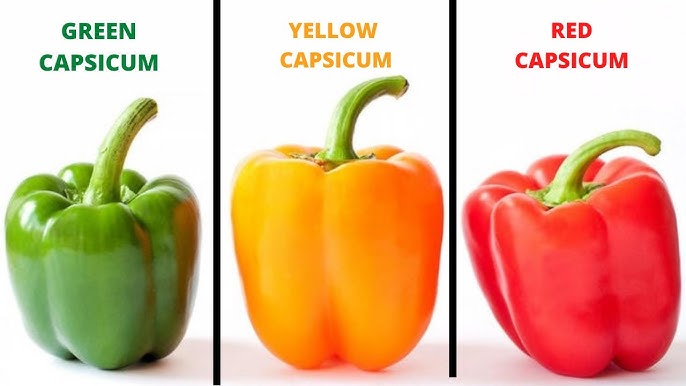Introduction:
Capsicum, or bell pepper, is a widely enjoyed vegetable from the Solanaceae family, which also includes tomatoes and potatoes. Originally from Central and South America, it is now grown globally. Known for its vivid colors—green, red, yellow, and orange—each hue represents a different stage of ripeness and offers unique nutritional benefits.
Nutritional Information:
Capsicum, a nutrient-rich vegetable, boasts an impressive array of vitamins and minerals, making it an essential component of a balanced diet:
Vitamins: Abundant in vitamins A, C, E, and an array of B vitamins such as B6 and folate.
Vitamin C: Supports a robust immune system, boosts iron absorption, and offers antioxidant benefits.
Vitamin A: Enhances vision, promotes healthy skin, and boosts immune function.
Vitamin E: Functions as an antioxidant, safeguarding cells from oxidative harm.
Minerals: Rich in potassium, magnesium, and calcium.
Potassium: Vital for heart health, muscle function, and nerve regulation.
Magnesium: Enhances muscle and nerve function while supporting protein synthesis.
Antioxidants: Comprising carotenoids (like beta-carotene and lutein) and flavonoids, these substances help alleviate oxidative stress and inflammation.
Dietary Fiber: Promotes digestive health and aids in weight management.
Health Advantages:
Enhances Immune Function: Rich in vitamin C, it fortifies the immune system, aiding the body in combating infections and diseases.
Enhances Eye Health: Carotenoids, especially beta-carotene, contribute to optimal vision and may lower the risk of age-related macular degeneration.
Promotes Heart Health: Rich in antioxidants and potassium, it reduces inflammation and helps regulate blood pressure, contributing to overall cardiovascular well-being.
Supports Digestion: Rich in dietary fiber, capsicum enhances digestion and helps prevent constipation.
Supports Weight Management: Rich in nutrients yet low in calories, capsicum can be a valuable component of a weight management strategy.

Culinary Applications:
Raw: Enjoy capsicum raw in salads, sandwiches, or as a crunchy snack.
Cooked: Often incorporated into stir-fries, soups, stews, and roasted dishes. Cooking elevates its sweetness and flavor.
Stuffed: Hollowed bell peppers can be filled with a variety of grains, meats, or vegetables and then baked to perfection.
Sauces and Soups: Frequently utilized in creating sauces, salsas, and soups, it imparts depth and richness to these dishes.
Varieties
Green Capsicum: These unripe bell peppers offer a firm texture and a mildly bitter taste, less sweet than their ripened counterparts.
Red Capsicum: Fully ripened bell peppers boasting a sweet, robust flavor. They offer higher levels of vitamins and antioxidants than green peppers.
Yellow and Orange Capsicum: These vibrant peppers are fully ripened, providing a gentler sweetness compared to their red counterparts.

Storage and Management:
Storage: To keep capsicum fresh, store it in the refrigerator’s crisper drawer. Properly stored, it can last between 1-2 weeks.
Handling: Thoroughly rinse bell peppers under running water prior to consumption or cooking to eliminate dirt and pesticide residues.
Health and Safety Guidelines:
Allergies: Although uncommon, some people might have allergic reactions to bell peppers. Symptoms can include itching, swelling, or digestive issues.
Interactions: Capsicum is typically safe when consumed in regular dietary quantities. Nevertheless, if you have any medical conditions or are taking medications, seek personalized guidance from a healthcare professional.
Capsicum is a versatile, nutritious vegetable that elevates the flavor and nutritional profile of numerous dishes. Adding it to your diet provides various health benefits and introduces vibrant color and variety to your meals.
